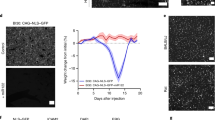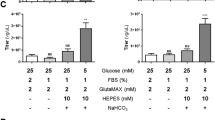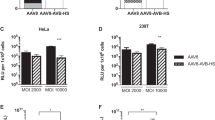Abstract
Transduction of the vascular endothelium by adeno-associated virus (AAV) vectors would have broad appeal for gene therapy. However, levels of transduction by AAV serotype-2 are low, an observation linked to deficiencies in endothelial cell binding, sequestration of virions in the extracellular matrix and/or virion degradation by the proteasome. Strategies to improve transduction of endothelial cells include AAV-2 capsid targeting using small peptides isolated by phage display or the use of alternate serotypes. Previously, we have shown that AAV serotypes-3 through -6 transduce endothelial cells with poor efficiency. Recently, AAV serotypes-7 and -8 have been shown to mediate efficient transduction of the skeletal muscle and liver, respectively, although their infectivity profile for vascular cells has not been addressed. Here, we show that AAV-7 and -8 also transduce endothelial cells with poor efficiency and the levels of transgene expression are markedly enhanced by inhibition of the proteasome. In both cases proteasome blockade enhances the nuclear translocation of virions. We further show that this is vascular cell-type selective since transduction of smooth muscle cells is not sensitive to proteasome inhibition. Analysis in intact blood vessels corroborated these findings and suggests that proteasome degradation is a common limiting factor for endothelial cell transduction by AAV vectors.
This is a preview of subscription content, access via your institution
Access options
Subscribe to this journal
Receive 12 print issues and online access
$259.00 per year
only $21.58 per issue
Buy this article
- Purchase on Springer Link
- Instant access to full article PDF
Prices may be subject to local taxes which are calculated during checkout




Similar content being viewed by others
References
Yla-Herttuala S, Martin J . Cardiovascular gene therapy. Lancet 2000; 355: 213–217.
Hedman M et al. Safety and feasibility of catheter-based local intracoronary vascular endothelial growth factor gene transfer in the prevention of postangioplasty and in-stent restenosis and in the treatment of chronic myocardial ischemai. Phase II results of the Kupoio Angiogenesis Trial (KAT). Circulation 2003; 107: 2677–2683.
Grines C et al. Angiogenic gene therapy (AGENT) trial in patients with stable angina pectoris. Circulation 2002; 105: 1291–1297.
Lemarchand P, Jones M, Yamada I, Crystal RG . In vivo gene transfer and expression in normal uninjured blood vessels using replication-deficient recombinant adenovirus vectors. Circ Res 1993; 72: 1132–1138.
French BA et al. Percutaneous transluminal in vivo gene transfer by recombinant adenovirus in normal procine coronary arteries, atherosclerotic arteries, and two models of coronary restenosis. Circulation 1994; 90: 2402–2413.
George S et al. Adenovirus-mediated gene transfer of the human TIMP-1 gene inhibits smooth muscle cell migration and neomintimal formation in human saphenous vein. Hum Gene Ther 1998; 9: 867–877.
Newman KD et al. Adenovirus-mediated gene transfer into normal rabbit arteries results in prolonged vascular cell activation, inflammation, and neointimal hyperplasia. J Clin Invest 1995; 96: 2955–2965.
Maeda Y et al. Gene transfer into vascular cells using adeno-associated virus (AAV) vectors. Cardiovas Res 1997; 35: 514–521.
Richter M et al. Adeno-associated virus vector transduction of vascular smooth muscle cells in vivo. Physiol Genomics 2000; 2: 117–127.
Melo LG et al. Gene therapy strategy for long-term myocardial protection using adeno-associated virus-mediated delivery of heme oxygenase gene. Circulation 2002; 105: 602–607.
Nicklin S et al. Efficient and selective AAV2-mediated gene transfer directed to human vascular endothelial cells. Mol Ther 2001; 4: 174–181.
Pajusola K et al. Cell-type-specific characteristics modulate the transduction efficiency of adeno-associated virus type 2 and restrain infection of endothelial cells. J Virol 2002; 76: 11530–11540.
Yan Z et al. Distinct classes of proteasome-modulating agents cooperatively augment recombinant adeno-associated virus type 2 and type 5 mediated transduction from the apical surfaces of human airway epithelia. Virology 2004; 78: 2863–2874.
Duan D et al. Endosomal processing limits gene transfer to polarized airway epithelia by adeno-associated virus. J Clin Invest 2000; 105: 1573–1587.
Wilson SH et al. Activated nuclear factor-kappa B is present in the coronary vasculature in experimental hypercholesterolemia. Atheroscelerosis 2000; 148: 23–30.
Herrmann J, Gulati R, Napoli C . Oxidative stress-related increase in ubiquitination in early coronary atherosclerosis. FASEB J 2003; 17: 1730–1732.
Herrmann J, Ciechanover A, Lerman LO, Lerman A . The ubiquitin-proteasome system in cardiovascular diseases – a hypothesis extended. Cardiovasc Res 2004; 61: 11–21.
Baker AH . Targeting AAV vectors. Mol Ther 2003; 4: 433–434.
White S et al. Gene delivery to vascular tissue in vivo by tropism-modified adeno-associated virus vectors. Circulation 2004; 109: 513–519.
Work L et al. Development of efficient viral vectors selective for vascular smooth muscle cells. Mol Ther 2004; 9: 198–208.
Dishart KL et al. Third-generation lentivirus vectors efficiently transduce and phenotypically modify vascular cells: implications for gene therapy. J Mol Cell Cardiol 2003; 35: 739–748.
Gao G-P et al. Novel adeno-associated viruses from rhesus monkeys as vectors for human gene therapy. Proc Natl Acad Sci USA 2002; 99: 11854–11859.
Sarkar R et al. Total correction of hemophilia A mice with canine FVIII using an AAV 8 serotype. Gene Therapy 2004; 103: 1253–1260.
Louboutin J et al. Gene transfer into skeletal muscle using novel AAV serotypes. J Gen Med, E-pub ahead of print.
Nicol CG et al. Effect of adenovirus serotype 5 fiber and penton modifications on in vivo tropism in rats. Mol Ther 2004; 10: 343–353.
Maher PA . Nuclear translocation of fibroblast growth factor (FGF) receptors in response to FGF-2. J Cell Biol 1996; 134: 529–536.
Sperinde GV, Nugent MA . Heparan sulfate proteoglycans control intracellular processing of bFGF in vascular smooth muscle cells. Biochemistry 1998; 38: 13153–13164.
Acknowledgements
We thank Nicola Britton for technical assistance. This work was funded by the Medical Research Council (UK), National Kidney Research Fund (UK) and the Biotechnology and Biomedical Sciences Research Council.
Author information
Authors and Affiliations
Rights and permissions
About this article
Cite this article
Denby, L., Nicklin, S. & Baker, A. Adeno-associated virus (AAV)-7 and -8 poorly transduce vascular endothelial cells and are sensitive to proteasomal degradation. Gene Ther 12, 1534–1538 (2005). https://doi.org/10.1038/sj.gt.3302564
Received:
Accepted:
Published:
Issue Date:
DOI: https://doi.org/10.1038/sj.gt.3302564
Keywords
This article is cited by
-
Recent advances in various adeno-associated viruses (AAVs) as gene therapy agents in hepatocellular carcinoma
Virology Journal (2024)
-
Strategies for delivering therapeutics across the blood–brain barrier
Nature Reviews Drug Discovery (2021)
-
Retina transduction by rAAV2 after intravitreal injection: comparison between mouse and rat
Gene Therapy (2019)
-
Promise of adeno-associated virus as a gene therapy vector for cardiovascular diseases
Heart Failure Reviews (2017)
-
Effect of bortezomib on the efficacy of AAV9.SERCA2a treatment to preserve cardiac function in a rat pressure-overload model of heart failure
Gene Therapy (2014)



